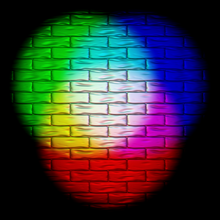Additive colororadditive mi xingis a property of acolor modelthat predicts the appearance ofcolorsmade by coincident componentlights,i.e. the perceived color can be predicted by summing the numeric representations of the component colors.[1]Modern formulations ofGrassmann's laws[2]describe the additivity in the color perception of light mixtures in terms of algebraic equations. Additive color predicts perception and not any sort of change in the photons of light themselves. These predictions are only applicable in the limited scope of color matching experiments where viewers match small patches of uniform color isolated against a gray or black background.


Additive color models are applied in the design and testing of electronic displays that are used to render realistic images containing diverse sets of color usingphosphorsthat emit light of a limited set ofprimary colors.Examination with a sufficiently powerful magnifying lens will reveal that each pixel inCRT,LCD,and most other types of color video displays is composed of red, green, and blue light-emitting phosphors which appear as a variety of single colors when viewed from a normal distance.
Additive color, alone, does not predict the appearance of mixtures of printed color inks, dye layers in colorphotographsonfilm,or paint mixtures. Instead,subtractive coloris used to model the appearance ofpigmentsordyes,such as those inpaintsandinks.
The combination of two of the common three additiveprimary colorsin equal proportions produces an additivesecondary color—cyan,magentaoryellow.Additive color is also used to predict colors from overlapping projected colored lights often used in theatrical lighting for plays, concerts, circus shows, and night clubs.[3]
The fullgamutof color available in any additive color system is defined by all the possible combinations of all the possibleluminositiesof each primary color in that system. Inchromaticityspace, a gamut is a planeconvex polygonwith corners at the primaries. For three primaries, it is atriangle.
History
editSystems of additive color are motivated by theYoung–Helmholtz theoryoftrichromatic color vision,which was articulated around 1850 byHermann von Helmholtz,based on earlier work byThomas Young.For his experimental work on the subject,James Clerk Maxwellis sometimes credited as being the father of additive color.[4]He had the photographerThomas Suttonphotograph a tartan ribbon on black-and-white film three times, first with a red, then green, then blue color filter over the lens. The three black-and-white images were developed and then projected onto a screen with three different projectors, each equipped with the corresponding red, green, or blue color filter used to take its image. When brought into alignment, the three images (a black-and-red image, a black-and-green image and a black-and-blue image) formed a full-color image, thus demonstrating the principles of additive color.[5]
See also
editReferences
edit- ^MacEvoy, Bruce."handprint: colormaking attributes".handprint.RetrievedFebruary 26,2019.
- ^MacEvoy, Bruce."handprint: colormaking attributes".handprint.RetrievedFebruary 26,2019.
- ^David Briggs (2007)."The Dimensions of Color".Archivedfrom the original on September 28, 2015.RetrievedNovember 23,2011.
- ^"James Clerk Maxwell".Inventor's Hall of Fame, Rochester Institute of Technology Center for Imaging Science.Archivedfrom the original on September 18, 2010.
- ^Robert Hirsch (2004).Exploring Colour Photography: A Complete Guide.Laurence King Publishing.ISBN1-85669-420-8.Archivedfrom the original on February 25, 2017.
External links
edit- RGB and CMYK Colour systems.
- http:// edinphoto.org.uk/1_P/1_photographers_maxwell.htm- Photos and stories from the James Clerk Maxwell Foundation.
- Stanford University CS 178interactive Flash democomparing additive and subtractive color mi xing.